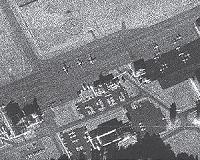 |
Bonn, Germany (SPX) Mar 05, 2010 On 13 March 2008, the International Space Station (ISS) passed across the field-of-view of Germany's remote sensing satellite, TerraSAR-X, at a distance of 195 kilometres (122 miles) and at a relative speed of 34,540 kilometres per hour (over 22,000 mph). The encounter lasted for about three seconds, but this brief moment was long enough for the synthetic aperture radar on TerraSAR-X to acquire an image of the ISS, a structure measuring about 110 metres by 100 metres by 30 metres. Just a few hours before this image was taken, Space Shuttle Endeavour was docked with the ISS as part of the 1J/A mission; its payload was the Japanese Logistics Module. At the time this picture was taken, the ISS was already truly international: the Russian and American modules as well as the European 'Columbus' laboratory were all installed. The impressive solar power plant on the Space Station was almost ready for operation, with six of its eight panels already in position. The orbital configuration that provides the opportunity for a picture like this occurs between 10 and 11 times each month, but there is absolutely no risk of a collision because TerraSAR-X and the ISS are on very different orbits.
Radar image of the ISS The radar image of the ISS therefore looks like a dense collection of bright spots from which the outlines of the Space Station can be identified clearly. The central element on the ISS, to which all the modules are docked, has a lattice grid structure with several surfaces to reflect the radar beam, making it readily identifiable. This image has a resolution of about one metre. In other words, objects can be depicted as discrete units - that is, shown separately - provided that they are at least one metre apart. If they are closer together, they tend to merge into a single block on a radar image. However, if they have good reflective properties, objects measuring less than one metre can be portrayed effectively. Having said that, the radar image will always enlarge them to at least one metre - there being no way around the laws of physics in this case.
The TerraSAR-X mission TerraSAR-X works regardless of weather conditions, cloud cover or the absence of daylight and is able to provide radar data with a resolution down to one metre. DLR is responsible for using TerraSAR-X data for scientific purposes. It is also responsible for planning and implementing the mission as well as controlling the satellite. Astrium built the satellite and shares the costs of developing and using it. Infoterra GmbH, a subsidiary company founded specifically for this purpose by Astrium, is responsible for marketing the data commercially.
Share This Article With Planet Earth
Related Links Microwaves and Radar Institute, SAR Technology Space Technology News - Applications and Research
 Northrop Grumman Delivers First Production STARLite Radars To US Army
Northrop Grumman Delivers First Production STARLite Radars To US ArmyBaltimore MD (SPX) Feb 12, 2010 Northrop Grumman has delivered the first two production AN/ZPY-1 STARLite radars for the U.S. Army's Extended Range / Multi-Purpose Unmanned Aerial System. Northrop Grumman's STARLite is a small, lightweight radar used for supporting tactical operations. By providing precise battlefield intelligence in all types of weather and in battlefield obscurants, day and night, STARLite significantl ... read more |
|
| The content herein, unless otherwise known to be public domain, are Copyright 1995-2010 - SpaceDaily. AFP and UPI Wire Stories are copyright Agence France-Presse and United Press International. ESA Portal Reports are copyright European Space Agency. All NASA sourced material is public domain. Additional copyrights may apply in whole or part to other bona fide parties. Advertising does not imply endorsement,agreement or approval of any opinions, statements or information provided by SpaceDaily on any Web page published or hosted by SpaceDaily. Privacy Statement |